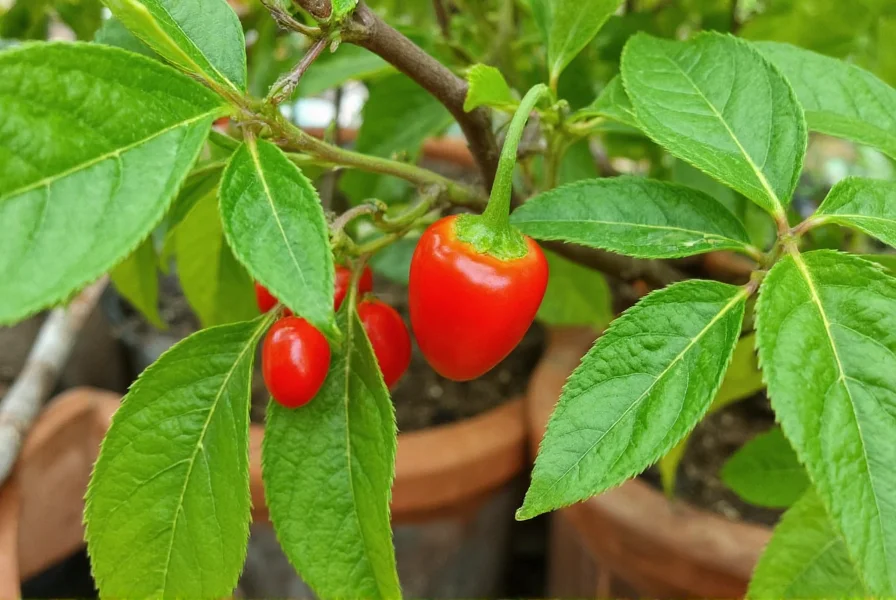Native to the high-altitude regions of the Andes, Peruvian puff pepper (Capsicum pubescens) stands apart from other chili varieties with its distinctive characteristics and culinary applications. Known locally as rocoto or locoto, this pepper has been cultivated since pre-Columbian times and remains an essential ingredient in Andean cuisine. The plant's scientific name pubescens refers to the fine hairs covering its leaves and stems, a feature not found in other Capsicum species.
Botanical Characteristics of Peruvian Puff Pepper
Peruvian puff pepper plants typically grow 3-5 feet tall with dark green, hairy leaves that help protect against intense mountain sunlight. The flowers feature purple corollas and black anthers, distinguishing them from other chili varieties. The fruits themselves range from heart-shaped to round, starting green and maturing to vibrant red, orange, or yellow.
What truly sets Peruvian rocoto peppers apart is their black seeds—a characteristic unique among cultivated chili peppers. While most chilies have white or yellow seeds, the puff pepper's dark seeds contribute to its distinctive appearance and slightly different flavor profile.
| Characteristic | Peruvian Puff Pepper | Comparison to Other Chilies |
|---|---|---|
| Scientific Name | Capsicum pubescens | Different species from jalapeños (C. annuum) or habaneros (C. chinense) |
| Seed Color | Black | Most chilies have white or yellow seeds |
| Leaf Texture | Hairy (pubescent) | Other species have smooth leaves |
| Heat Level | 5,000-25,000 SHU | Milder than habaneros (100,000-350,000 SHU) |
Growing Requirements for Authentic Peruvian Puff Pepper
Cultivating genuine Andean puff pepper plants requires specific conditions that mimic their native high-altitude environment. These peppers thrive at elevations between 5,000-10,000 feet where temperatures remain consistently moderate—neither too hot nor too cold. Unlike many commercial chili varieties, Peruvian puff peppers cannot tolerate extreme heat and perform best with daytime temperatures between 65-75°F (18-24°C) and nighttime temperatures around 50-60°F (10-15°C).
Successful growing Peruvian rocoto peppers at home requires well-draining soil with a slightly acidic pH (6.0-6.8). The plants need consistent moisture but cannot tolerate waterlogged conditions. Gardeners outside the Andes region often achieve best results by growing these peppers in containers that can be moved indoors during temperature extremes.

Culinary Applications of Peruvian Puff Pepper
In traditional Andean cooking, Peruvian puff pepper uses extend far beyond simple heat addition. The rocoto's complex flavor profile—fruity with berry notes and moderate heat—makes it ideal for sauces that balance spice with depth of flavor. Peruvians often remove the seeds and some membranes to reduce heat before incorporating the peppers into dishes.
One of the most famous preparations is rocoto relleno, a traditional Arequipa dish featuring stuffed rocoto peppers. The peppers are parboiled to reduce heat, then filled with a mixture of ground meat, vegetables, and spices, and baked with cheese sauce. This dish showcases how authentic Peruvian rocoto recipes transform the pepper's natural heat into a balanced culinary experience.
For home cooks interested in using Peruvian puff peppers in modern cuisine, consider these applications:
- Add finely diced rocoto to fruit salsas for tropical dishes
- Blend with tomatoes and herbs for a distinctive hot sauce
- Use in ceviche for authentic Peruvian flavor
- Infuse vinegar with rocoto for spicy condiments
Safety Considerations and Proper Handling
When working with Peruvian puff pepper heat levels, proper handling is essential. Despite being milder than some super-hot varieties, rocotos still contain significant capsaicin that can cause skin and eye irritation. Always wear gloves when handling these peppers, especially when removing seeds and membranes.
Those new to cooking with authentic rocoto peppers should start with small quantities, as individual heat tolerance varies. The heat builds gradually and can be surprisingly intense compared to what the pepper's appearance suggests. If consuming too much, dairy products like milk or yogurt provide the most effective relief, as capsaicin is fat-soluble.

Cultural Significance in Andean Communities
The history of Peruvian puff pepper cultivation dates back thousands of years, with archaeological evidence suggesting domestication as early as 6000 BCE. Unlike many chili varieties that spread globally after European contact, rocoto remained primarily confined to the Andean region, maintaining its cultural significance among indigenous communities.
In traditional Andean agriculture, Peruvian rocoto growing practices often incorporate companion planting with potatoes and corn, following ancient methods that optimize soil health and pest management. Many small-scale farmers still use these traditional techniques, preserving agricultural biodiversity in the process.
Frequently Asked Questions
What makes Peruvian puff pepper different from other chili varieties?
Peruvian puff pepper (Capsicum pubescens) is unique due to its hairy leaves, black seeds, and ability to grow at high altitudes. Unlike other chili species, it cannot cross-pollinate with common varieties like jalapeños or habaneros. The puff pepper also has a distinctive flavor profile—fruity with berry notes—and moderate heat that builds gradually rather than hitting immediately.
How hot is the Peruvian puff pepper compared to other chilies?
Peruvian puff pepper (rocoto) measures between 5,000-25,000 Scoville Heat Units, placing it in the medium heat range. This makes it hotter than jalapeños (2,500-8,000 SHU) but significantly milder than habaneros (100,000-350,000 SHU). The heat builds gradually and has a distinctive lingering quality that differs from the immediate burn of many other chili varieties.
Can I grow Peruvian puff pepper outside of South America?
Yes, you can grow Peruvian puff pepper outside South America with proper care. These plants require moderate temperatures (65-75°F daytime, 50-60°F nighttime), well-draining soil, and protection from extreme heat. Gardeners in temperate climates often grow them in containers that can be moved indoors during temperature extremes. The key challenge is replicating the high-altitude Andean conditions where these peppers naturally thrive.
How do I reduce the heat when cooking with Peruvian puff peppers?
To reduce heat when cooking with Peruvian puff peppers, remove the seeds and white membranes (placenta) where most capsaicin concentrates. Parboiling the peppers for 2-3 minutes before use also helps reduce heat. For traditional Peruvian preparations like rocoto relleno, peppers are often soaked in milk or salt water to further mellow the heat while preserving flavor.











 浙公网安备
33010002000092号
浙公网安备
33010002000092号 浙B2-20120091-4
浙B2-20120091-4